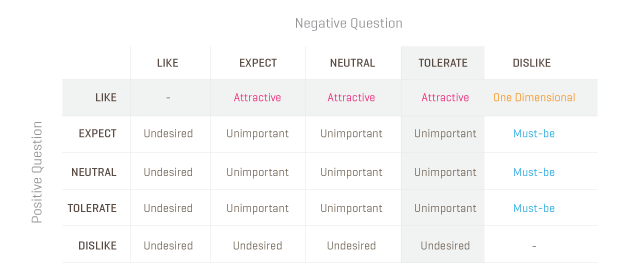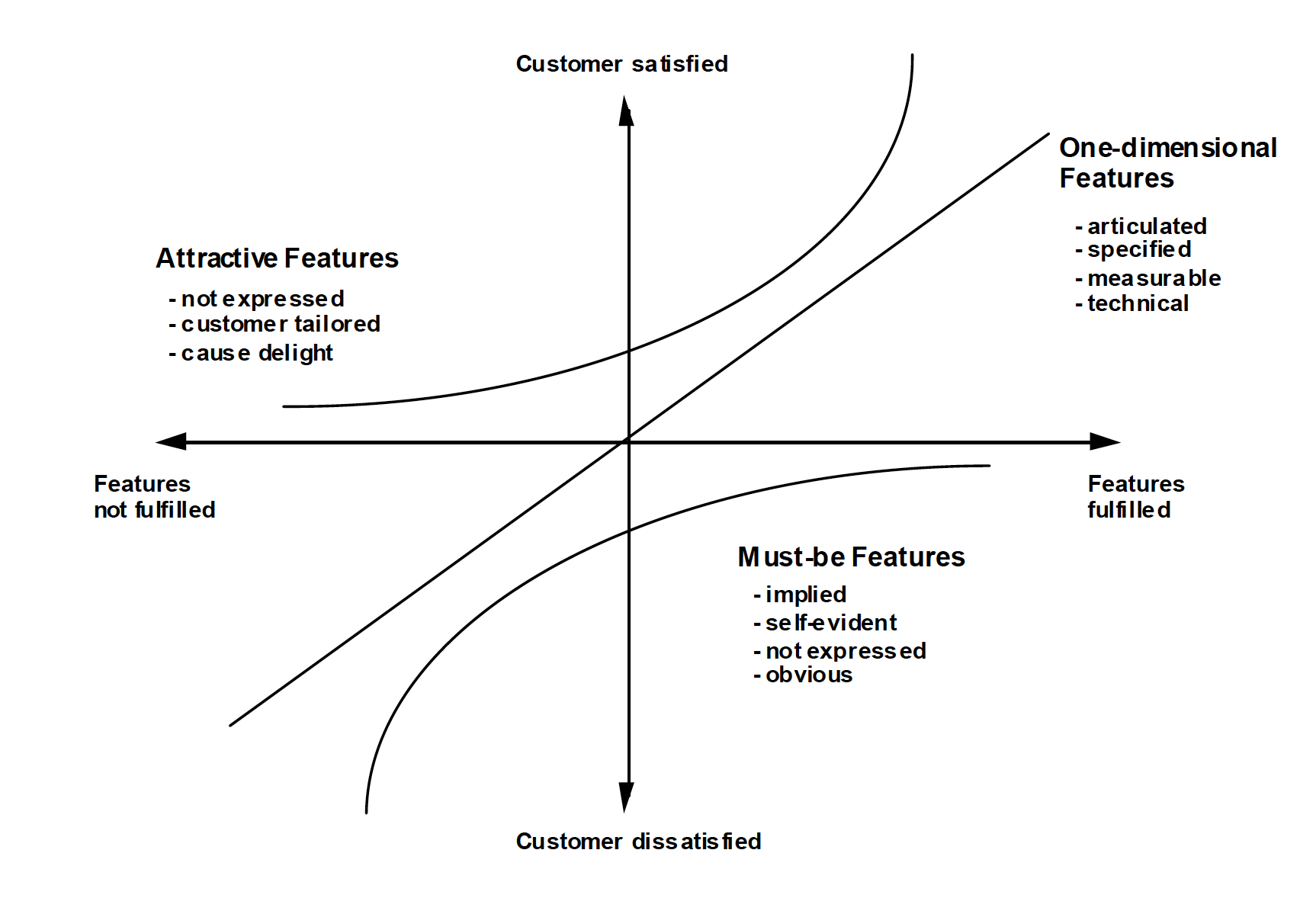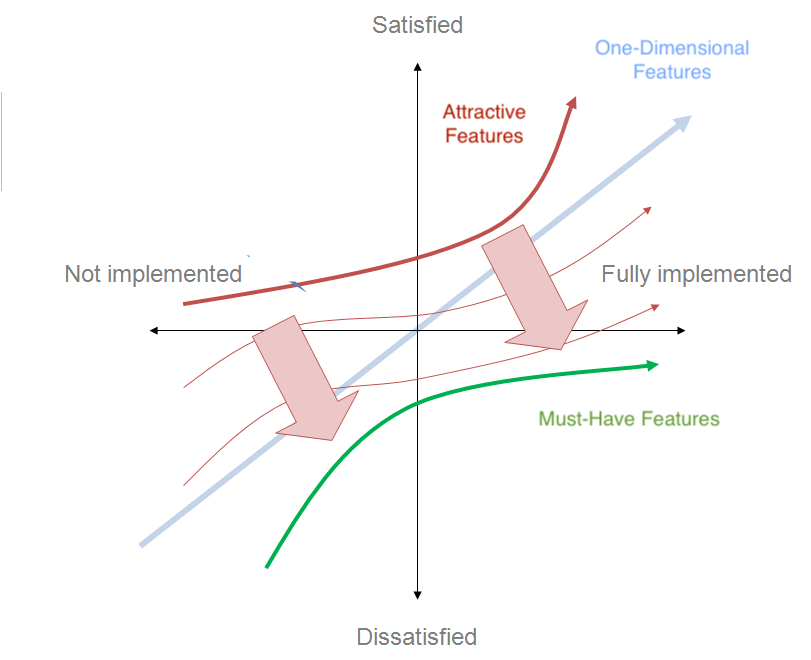Introduction
It is always significant to make users delightful when engaging with the products, however, it can be extremely challengable either to measure their emotional reactions towards products or to prioritize them. This is where Kano Model comes into play, which is used for measuring desirability of different product features. This post will breifly introduce this method and discuss its advantages/disadvantages.
Method
Kano Model was developed by Professor Noriaki Kano in the 1980s while studying the factors contribute to customer satisfaction and loyalty. It suggests 5 different emotional response types to conclude users’ attitude towards product features, and can be very insightful for companies to understand users’ emotion toward different product features and prioritize their effort while developing their products.
A Kano Model Analysis follows 4 step:
- Step 1. Identify Features for Evaluation
- Step 2. Construct the Questionnaire
- Step 3. Interview / Survey
- Step 4. Evaluate & Interprete
Questionnaire
A typical questionnaire for Kano Model Analysis consists of two questions for each feature:
- Positive Question: “how would you feel if this feature were present?”
- Negative Question: “how would you feel if this feature were absent?”
With 5 choices of response for respondents:
- I like it
- I expect it
- I’m neutral
- I can tolerate it
- I dislike it
The presentation of the question is suggested to be facilitated with prototypes, so users could better get the idea of the feature while evaluating.
Evaluation Table
Kano Evaluation Table by Jan Moorman
Based on users’ responses to the negative and positive question for a certain feature, their attitudes on the feature can be interpreted to a specific reaction category as shown in the table. There are totally 5 categories concluded by Professor Kano, which will be discussed further in the next section.
Kano’s 5 Emotional Response Types
Kano’s model of customer satisfaction (Berger et al., 1993)
5 Types
Must-Have Features
Must-Have features caused disappointment if has not been presented, but users remain neutral if they have been implemented. These features are considered to be basic product criteria. An example is the sending message feature in IM app.
One-dimensional Features
This type has a linear relationship between the fulfillment of the feature and the satisfaction of it, that users are not satisfied if the feature has been missed, but like it if it exists. They are customers’ explicit demands, like the security of users’ bank accounts.
Attractive Features
Attractive features stimulate users’ delight while present, but they are not dissatisfied if these features are absent. These features will generate more than propositional satisfaction if being implemented.
Unimportant Features
Unimportant Features refer to those that users do not care if they are included or not.
Undesired Features
Users are even getting dissatisfied if Undesired Features are implemented.
Change of Types
The types of users’ emotional response changes over time that Attractive Features may become Must-Have Feature. For an example, in the era of SMS, “sending photos” can be an attractive features to delight users, but right now, it is must-have for any messaging app.
Description of how attributes values change over time in the Kano model (Craigwbrown, 2012)
Pros & Cons
- Provides accurate and valuable insight into if the company should invest in a certain feature
- A worthy way to improve customer satisfaction with your products
- Is tedious for the interview process, can be long and take up a lot of time
- Analyzing this type of data is certainly not easy. There is a considerable amount (at least 20) you need to do to get an accurate analysis.
References
Berger, C., Blauth, R., Boger, D., Bolster, C., Burchill, G., DuMouchel, W., Pouliot, F., Richter, R., Rubinoff, A., Shen, D., Timko, M. and Walden, D. (1993). Kano’s Methods for Understanding Customer-defined Quality. Center for Quality Management Journal, 4 (Fall 1993).
Kano, N., Seraku, N., Takahashi, F. and Tsuji, S. (1984). Attractive Quality and Must-be Quality. The Journal of the Japanese Society for Quality Control,, April 1984.
Matzler, K., Hinterhuber, H., Bailom, F. and Sauerwein, E. (1996). How to delight your customers. Journal of Product & Brand Management, 5(2), pp.6-18.
Moorman, J. (2018). Leveraging the Kano Model for Optimal Results | UX Magazine. [online] Uxmag.com. Available at: https://uxmag.com/articles/leveraging-the-kano-model-for-optimal-results [Accessed 23 Oct. 2018].
Olsen-landis, C. (2018). Kano Model — Ways to use it and NOT use it – Design at IBM – Medium. [online] Medium. Available at: https://medium.com/design-ibm/kano-model-ways-to-use-it-and-not-use-it-1d205a9cf808 [Accessed 23 Oct. 2018].
SurveyMethods.com. (2018). Benefits and Weakness of the Kano Survey. [online] Available at: https://surveymethods.com/blog/benefits-and-weakness-of-the-kano-survey/ [Accessed 23 Oct. 2018].



